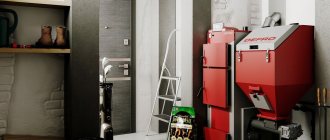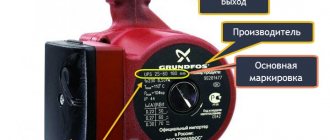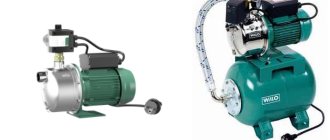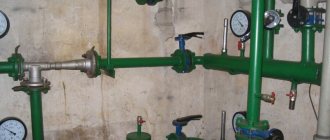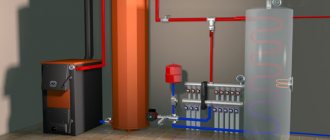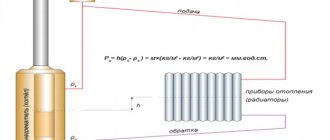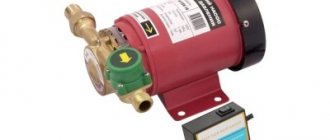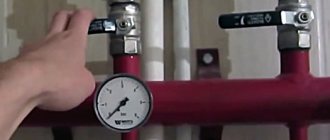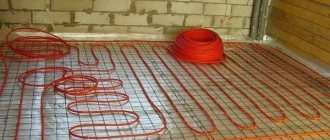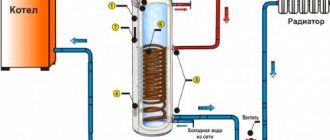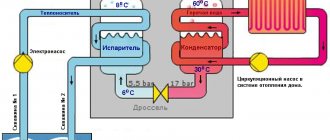If, in the case of choosing a pump, the question arose, which is better - a pump with a wet rotor or a dry one, then we will try to understand such units using the example of circulation pumps. It is known that such equipment is successfully used to create excellent and uninterrupted coolant circulation in the heating system of a private home.
In operating condition, a pump with any type of rotor forces a volume of liquid through the pipes, forcing it to constantly move forward. As a result of this effect on the coolant, we have the following advantages:
- Constant temperature indicator of radiators in all areas of the heating system;
- The absence of air locks in the system, which means eliminating the possibility of water hammer in it;
- Saving family money on fuel or electricity consumption for heating the coolant (now there is no need to fire the boiler intensively so that the desired water temperature quickly reaches the radiators in the back room of the house and warms it up). Wet or dry rotor pumps will make everything faster and more productive.
Important: pumps with rotors of all types have two openings in their design: suction and discharge. Thus, the unit does its job, moving it along a closed circuit.
How does such a unit work?
Circulation pumps have a structure similar to drainage pumps. The pump body with a dry or wet rotor is most often made of durable alloys such as brass, cast iron, stainless steel or bronze. Such metals interact well with high-temperature water or aggressive media (in the case of a drainage rotor).
The rotor itself is made of either durable stainless steel or ceramic. And the working unit (wheel with blades) is placed on the rotor shaft.
BC 1xBet has released an application, now you can officially click on the active link for free and without any registration.
The operating principle of such a device is to create centrifugal force inside the pump and looks like this:
When turned on, the rotor drives a wheel with an impeller, which rotates quite quickly, creating a decrease in pressure in the pump chamber. This promotes the flow of water into the tank. Next, the water that gets into the chamber increases the pressure and at the same time is pressed against the walls of the internal reservoir of the pump. As a result of this difference, water is pushed out into the outlet. The cycle is repeated again and again until the unit turns off.
Purpose of circulation pumps
The operating principle of a standard closed-type heating system is quite simple. The boiler heats the water, which passes through the radiators, releasing the accumulated heat
In the case of natural circulation, it is very important to maintain accuracy in design, maintaining a certain angle of inclination of the pipeline. However, due to the low speed of movement of the coolant, it quickly cools down, and cold liquid returns to the boiler, forcing it to constantly operate at full load.
To eliminate this drawback, different types of circulation pumps are used. Their purpose is to create the coolant pressure necessary to ensure uniform heat distribution between all elements of the system. First of all, this helps to reduce the requirements for compliance with slopes and pipeline cross-sections. At the same time, the difference in temperature of the liquid at the outlet and inlet of the boiler is only a few degrees, which significantly reduces the load on the heating equipment and reduces energy costs.
Division of pumps with a rotor into types
All pumping equipment with a rotor can be divided into two types:
- Units with a “wet” rotor;
- Pumps with a “dry” rotor.
In the first case, we are talking about a mechanism whose rotor does not have direct contact with the pumped water. The isolation of the rotor in the pump mechanism is supported by special ceramic or metal seals in the form of rings. They protect the rotor from direct contact of components with the pumped medium. But here the principle of operation of a device with a wet rotor is that between the protective rings rubbing against each other there is a thin, barely noticeable layer of water. It helps maintain the pressure difference in the heating system and in the working chamber, and therefore ensures the tightness of the rotor compartment. At the same time, during operation, the sealing rings rub against each other more strongly, which ensures even greater tightness of the device.
The principle of operation of the circulation pump
In addition, the principle of operation of a pump with a “wet” rotor is that the device’s engine is lubricated and cooled by the water that the pump pumps.
Important: circulation units for heating or air conditioning systems with a “wet” rotor can be either single-phase or three-phase. That is, such pumps can be used both at home and in a large production or industrial enterprise.
Thanks to precisely these operating principles, a unit with a “wet” rotor has a number of advantages:
- Low noise level when pumping water through the system;
- Modest weight and small dimensions;
- Possibility of long-term operation without stopping;
- Economical energy consumption;
- Easy to install, configure, maintain and repair.
At the same time, monoblock devices with a “wet” rotor are more popular among modern consumers.
Important: but along with all the listed advantages, the efficiency of a pump with a “wet” type rotor is significantly lower and is about 55%. Thus, it is best to use such a mechanism in houses with a small area, where the closed circuit of the heating system is of short length.
If we talk about water supply pumps with a “wet” type rotor, then here too the devices will be slightly inferior to their counterparts with a “dry” rotor. But this applies only to surface aggregates.
Important: a prerequisite for high-quality operation of a pump with a “wet” rotor and compliance with the principles of pumping water is the correct installation of the unit on the circuit. Here the equipment shaft must be positioned strictly horizontally relative to the closed circuit of the heating system. Only in this case will a high-quality supply of fluid to the bearings for lubrication of working units be ensured through the sleeve.
How to choose a circulation pump
Each circulation pump has a set of technical characteristics. They are selected individually for the parameters of each system.
Selecting technical specifications
Let's start with the selection of technical characteristics. There are a lot of formulas for professional calculations, but to select a pump for the heating system of a private house or apartment, you can get by with average standards:
Selecting a circulation pump for heating following these rules is not difficult. Elementary calculations. But it must be said that these figures are statistical averages. If your house at some point differs greatly from the “average” indicators, you need to make adjustments either towards increasing or decreasing technical characteristics. For example, you have insulated your house well, but the power of the previously purchased boiler turned out to be excessive. In this case, it makes sense to choose a pump with a lower capacity. In the opposite situation - the house is chilly in extreme cold - you can install a more efficient circulator. It will temporarily solve the problem (in the future you will need to either insulate or change the boiler).
Model selection
When choosing a specific model, pay attention to the graph with the pressure characteristics of the pump. On the graph you need to find the point at which the pressure and productivity values intersect
It should be located in the middle third of the curve. If it does not fall on one of the curves (there are usually several of them, characterizing different models), take the model whose graph is closer. If the point is in the middle, take the less productive one (the one located below).
What else to pay attention to
In the technical characteristics of circulation pumps there are several more items that are worth paying attention to. The first is the permissible temperature of the pumped medium
That is, the temperature of the coolant. In high-quality products this indicator ranges from +110°C to +130°C. In cheap ones it can be lower - up to 90°C (but in fact 70-80°C). If your system is designed as a low-temperature system, this is not a big deal, but if you have a solid fuel boiler, the temperature to which the coolant can be heated is very important.
It is also worth paying attention to the maximum pressure at which the pump can operate. In the heating system of a private house it is rarely higher than 3-4 atm (this is for a two-story house), but normally it is 1.5-2 atm
But still, pay attention to this indicator.
Something else to pay attention to is the material from which the case is made. The optimal one is cast iron, the cheaper one is made of special heat-resistant plastic
Connection type and size. The circulation pump can have threaded or flanged connections. The thread can be external or internal - appropriate adapters are selected for it. Connection sizes can be: G1, G2, G3/4.
It is also worth paying attention to the presence of protection. May have dry running protection
In circulation pumps with a wet rotor, it is very desirable, since the cooling of the motor occurs due to the moving medium. If there is no water, the motor overheats and fails.
Another type of protection is overheating protection. If the motor heats up to a critical value, the thermal relay turns off the power and the pump stops. These two features will extend the life of the equipment.
Pumps with a dry rotor
Here, the principle of operation of the mechanism is that the rotor operates without contact with water. At the same time, the efficiency of such a device is high, reaching as much as 80%.
Despite all their productive power, units of this type have a number of disadvantages:
- High noise level during operation.
- The need for constant monitoring of the quality of the processed medium, since pumps with a “dry” rotor do not tolerate the presence of foreign debris in the water or air molecules. Such “neighbors” can break the tightness of the sealing rings in the mechanism.
At the same time, the entire range of pumps with a “dry” rotor is divided into three types:
- Block devices;
- Vertical units, in which the engine is in a vertical position and both pipes are located on the same axis;
- Cantilever (horizontal) ones, in which the engine is mounted horizontally and the pipes are located perpendicular to each other.
Water pressure pump
For these purposes, two types of pumps are used in the household water supply network to increase the water pressure for the home - with a wet rotor and circulation.
The design of water pumps with a wet rotor increasing the water pressure in the water supply system
To correctly understand the operating principle of a device with a wet rotor, it is necessary to imagine the design of the engine. The motor (Fig. 1) consists of a stator and a rotor. The stator (3) contains coils that create a magnetic field moving in a circle, which captures the rotor (2) and rotates it together with the impeller (4). Being constantly in operation, the armature and rotor windings heat up.
[content-egg module=GdeSlon template=list limit=2 offset=0]
In order to increase cooling, these elements are placed in a sealed stainless steel waterproof housing - special armor (2) and circulation of pumped water is started between them.
The impeller, capturing water, drives it through the center between the stator and the rotor, squeezing it along the edge of the stator “jacket,” so the motor windings are constantly cooled by the pumped water. There is a drawback to this design - due to the additional gaps between the stator and rotor, the engine efficiency decreases and is only 60%. The design of the motor and rotor can be seen in Fig. 1
Rice. 1. Design of a pump with a “wet rotor”. 1 - housing, 2, 3 - rotor and stator, protected by a sealed jacket, 4 - impeller, 5 - water pipe.
The design of pumps that increase water pressure in a water supply system with a dry rotor.
Dry rotor - the name itself speaks about the design (Fig. 2). The working element of pumping water is a rotor wheel, which captures water from one end of the pipe and moves it along the tapering body, which allows the pressure to be increased to a certain level, and the engine itself is cooled by room air.
The advantages include the fact that the engines have greater efficiency compared to a wet rotor engine and, accordingly, are more economical. Such pumps are single-stage.
The disadvantages include the poor performance of the pump itself and the increased noise level during operation, so it is advisable to install it in separate rooms.
Fig.2. Design of a device with a “dry” motor rotor. The rotor wheel with a water chamber is separated from the engine by an oil seal. 1- Pump control, 2- Stator coil, 3- “Dry” rotor, 4 – Stuffing box seal, 5- Impeller, 6 – Water pipe flange.
Installation of a pump that increases water pressure.
The most common method of installing equipment is a technological technique called a bypass line. This technique was first used in America and translated from English means bypass line or bypass. In water supply and heating systems, bypass lines are used to install equipment on it so that in case of a malfunction it can be replaced and repaired without compromising the integrity of the entire system. From Fig. 3 you can easily work
Fig.3. Bypass line for pump installation. 1- Pump mounting fitting, 2 – Angle fitting, 3 – Filter, 4 – Pump, 5 – Tap on a straight line, 6 – straight line, 7 – Tap on a bypass line.
understand how the bypass line works. In order to start the pump, it is enough to turn off the tap on the straight line, then the water flow will pass through the bypass. To prevent large particles from getting under the pump impeller, it is necessary to install a filter. If space allows, it is better to install two – coarse and fine cleaning. To change equipment installed on the bypass line, it is enough to close the supply and return valves and open the valve on the main line.
You can buy a pump that increases water pressure for your home at any dealership or specialized stores in any city. You can also type equipment in the search bar and select the necessary equipment from the list provided.
Household water pumps increasing pressure Aqvario AC series.
Rice.
4. Models of household booster pumps Aquario. 1 - AC 159 160A, 2 - AC 1512 195A. The main purpose of this type of pump is to increase pressure in central water supply systems - apartments in multi-storey buildings, private houses, cottages connected to the central water supply network. Unfortunately, the presence of a central water supply does not always provide the necessary pressure in the pipes; especially on the upper floors, a situation often arises when the washing machine does not turn on, or there is not enough pressure to operate a flow-through gas water heater or pressure for lovers of a massage water shower.
[content-egg module=GdeSlon template=list limit=2 offset=0]
The pump that increases water pressure in the Aquario AC apartment is designed with a wet rotor and operates almost silently compared to other models.
Pump characteristics
It works in two modes: always on or automatic. The device has a built-in flow sensor, thanks to which it turns on when the tap is opened and turns off when closed. For the user, the automatic mode is most often optimal.
Depending on the model, pumps can be used to create pressure in front of one or several water points at the same time. The Aquario speaker line has only 2 models: AC 159 160A and AC 1512 195A (Fig. 4).
Model AC 159-160 A
[content-egg module=GdeSlon template=item limit=1 offset=0]
Power consumption is 120 W, increases water pressure to 0.7 atm (7 m), as a rule, this model provides only one water draw-off point, for example, to increase the pressure in front of a shower stall or flow-through water heater.
Model AC 1512 195A
[content-egg module=GdeSlon template=item limit=1 offset=1]
With a power consumption of 270 W, it increases the pressure in the system to 1.2 atm. (12m). It allows you to comfortably use several water points at the same time and can be installed at the very entrance to the water supply mains of a cottage or apartment.
To select the correct pump installation, you need to understand the markings. The pump marking reads as follows:
- AC – pump series;
- 15 – diameter of connecting thread;
- 12 – maximum pressure in meters;
- 195 – installation length in millimeters;
- A – automatic pump.
Attention!
- Installation of a water pump that increases water pressure should be carried out after completion of the installation of the water supply network of the entire building.
- When installing, the motor rotor must be in a strictly horizontal position.
- The constantly on mode requires monitoring of the operation of the device.
You can buy a pump that increases water pressure in an apartment on the Internet resources of specialized sites, or dealership centers for the sale of plumbing equipment.
Reviews about the Aquario AC 1512-195A model:
This is, perhaps, the only model with a wet rotor that provides a pressure of 12 m. Grundik has a pressure of 9 m at the same price. I couldn’t be happier with it, it works absolutely silently, it turns off itself when the flow decreases, I controlled everything clearly using a pressure gauge. It's only been in use for one year, but it seems well made.
I bought a high-pressure water pump Aquario AC 1512-195A, no complaints, but I could have bought it cheaper if I had immediately requested cashback. Believe me, these are not bonuses - these are real money, which after registration of the goods goes to your card or phone. Ask for discounts when purchasing. They definitely have stores hiding them.
[content-egg module=GdeSlon template=list limit=2 offset=0]
You can see the installation and operation in the video below.
| Attention Bearing Buyers Dear customers, send your questions and requests for the purchase of bearings and components by email or call now: Delivery of bearings throughout the Russian Federation and abroad. Bearing catalog on the website |
Attention Bearing Buyers
Dear customers, send your questions and requests for the purchase of bearings and components by mail or call now: tel: +7 (495) 646 00 12 [email protected] Delivery of bearings in the Russian Federation and abroad. Bearing catalog on the website
themechanic.ru
Attention Bearing Buyers
Dear customers, send your questions and requests for the purchase of bearings and components by mail or call now: tel: +7 (495) 646 00 12 [email protected] Delivery of bearings in the Russian Federation and abroad. Bearing catalog on the website
themechanic.ru
Rules for choosing a pump: “dry” or “wet” rotor
In order for the heating system to work as efficiently as possible, it is necessary to select the right pump in accordance with the parameters of the house and the characteristics of the heating system. Only in this case and provided that the mechanism is correctly installed in compliance with the principles of its operation, the heat in the house will be of high quality and long lasting.
Operating principle of a borehole screw pump
So, when choosing a pump, consider the following points:
- The total area of the house and the length of the closed circuit of the heating system;
- Number of radiators for the entire length of the heating system;
- Availability of “warm floor” systems, etc.;
- Quality and density of window metal-plastic bags;
- Insulation of walls, ceilings or roofs in a house.
Important: calculations of the required amount of heat should be carried out only by competent heating engineers, who will take into account all the important nuances and recommend a pump with pressure characteristics rated specifically for your room.
It is important to take into account that if you choose a pump for a heating system that already exists but requires modification, then it is better to buy an adjustable unit. This device perfectly adapts to the operating parameters of a given circuit.
Principles for installing units with any rotor
In order for the circulation equipment to work efficiently, it is better to invite specialists to install it. But if you want to install the pump yourself, then follow these rules:
- The unit is installed on the return side of the boiler. That is, where the water, having passed through the entire closed loop of the system, returns back again. But this rule applies to premises whose area does not exceed 150-200 m2.
- It is important to follow the location of the arrow on the pump body when installing it. The arrow should point in the direction of the movement of warm water through the system.
- All flange and threaded joints must be treated with sealant to avoid possible leaks.
- If you are dealing with a reverse circulation heating system, then it would be useful to install a bypass - a piece of pipe that, in case of repair of the unit, can close the heating circuit after removing the pump.
Popular models of pumps with a wet rotor
The most popular units for transporting water with “wet” type rotors are products manufactured by German, Danish and Canadian companies. The Wilo pump occupies a special place among the range of products.
The devices have a threaded connection and are equipped with a speed control system to control the performance and power of the pump. Wilo units are used in heating and air conditioning systems, as well as in cold water circulation systems in enterprises.
Grundfos pumps
Another leader in the modern Russian and global pumping equipment markets. Such pumps are characterized by high performance and reliability. Thanks to careful assembly by meticulous Danes, the units operate without failures or breakdowns for a long time.
Distinctive features of such mechanisms are:
- Absolute inertness to water and anti-corrosion properties of the metal;
- No need for frequent preventive maintenance and repairs (the wet rotor does its job);
- Reliable sealing of the housing.
Important: Grundfos pump casings are equipped with a special heat-protective casing, which prevents the risk of possible burns to the user.
